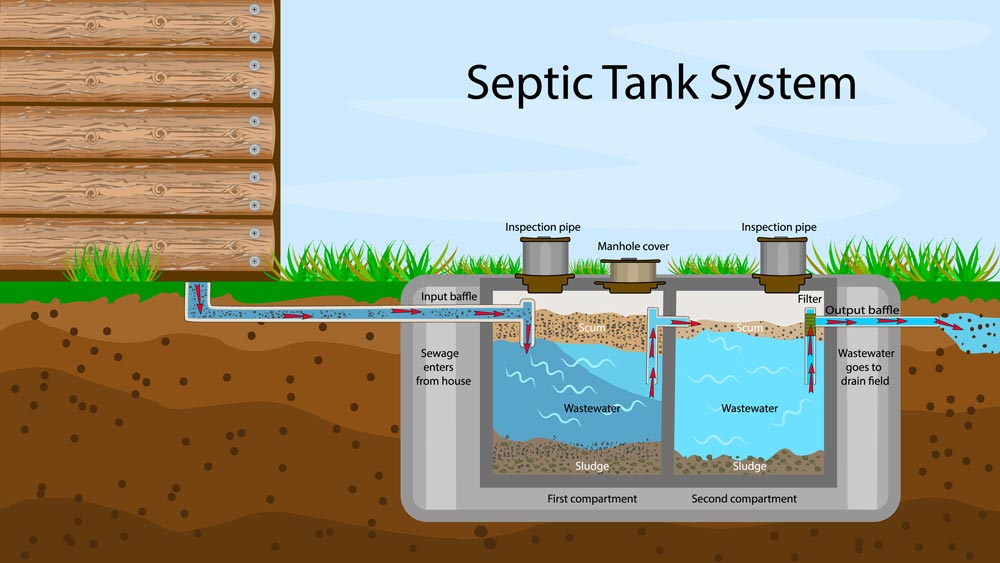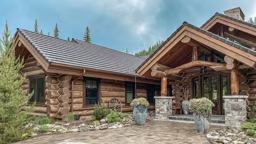
Dealing with waste removal isn’t the sexiest homeownership topic to discuss, but it is one that matters for every single home, whether it’s constructed with logs, is timber-framed or is built in some other fashion.
Tapping into a municipal sewer is by far the most convenient option, but let’s face it — if you’re building out in the country, which is where most log and timber homes are located, there’s a very good chance you are going to need a septic system.
Most people are at least somewhat familiar with the workings of an in-ground, gravity-fed septic system; however, topography, soil conditions and other site-specific factors may not be suitable for this type of arrangement, and in that case, an above-ground, or “mound” system may be necessary. Because they are not nearly as common or understood, that’s what we’re going to focus on here.
What is a mound septic system and how does it work?
The mound, itself, is a raised leach field. The way mound systems work is that the effluent is pumped from the house to a tank and into a pressure system, then leached under low pressure through pipes with small-diameter holes into a gently raised, above-ground field that’s specifically designed to accept, filter and dissipate the water. The bed has several layers, including a tilled layer, subsoil, sand, fabric and, ultimately, topsoil.
Why would my property need a mound system?
Most often a mound system is specified over an in-ground, gravity-fed system because the ground is comprised of substantial amounts of rock or clay or if the soil is shallow before you reach groundwater – all of which prevent wastewater from filtering and dissipating properly or safely.
It’s essential to enlist the help of a contractor who’s highly familiar with mound systems to ensure that each layer of the mound is properly designed and installed and then approved by a qualified inspector. If not, you run the risk of issues from the sewage odor penetrating the mound to (worse) polluting the groundwater and/or your home’s well-water supply.
Is there maintenance involved with mound systems?
In short, yes, and the maintenance on a mound system isn’t anything to ignore. I’m not saying that a gravity-fed system is maintenance free. You still need to monitor it and ensure that toilets or faucets aren’t running continuously and causing potential overflow, but in a mound system, there are a lot more moving parts to consider. There are pumps, assemblies, alarms and pipes — in short there are more opportunities to malfunction or clog than you’d have with an in-ground system. If you live in a rainy area, you also must keep an eye on possible erosion of the mound to prevent system failure.
The pumps and pipes in a mound system are attached to alarms, so if there’s an issue of some kind, you’ll be alerted. To keep hard deposits from building up, you should have your system pumped by a pro every few years. You can perform a visual check of your system via the test pipes (aka observation tubes) to ensure that the sewage is properly filtering and dissipating and not causing any groundwater issues.
But the most basic way to maintain a mound system is to preserve the area and prevent the compaction of the soil. This means cordoning the area off and keeping heavy equipment like tractors off the mound during and after the construction of your home (note: a lawnmower is just fine).
If you inspect the mound regularly and attend to any issues while they are minor, maintaining it should be easy.
Can I disguise or landscape the mound?
To allow the septic field to do its job, it’s best to allow the mound to be as natural as possible. I do recommend you cover it with grass, which will help reduce erosion. Plus, the regular mowing it will require will force you to keep an eye on the system, ensuring its health and viability.
If you must landscape the area near the mound, always use species with very shallow roots, like ornamental grasses and herbaceous plants. In fact, you could use these as a natural border or line of demarcation as a cue not to run over it. However, never plant large trees and other deep-rooted plants near the mound, as they can break the seal, causing severe damage and system failure. And never plant any kind of edible plant on top of your septic mound because of the high risk of bacterial contamination.
In short, if a mound system is the best septic option for your site, don’t fight it — there are quite a few benefits to it — just be sure to take care of it.

Smart Siting
Just because you receive approval for a septic system that will support a three-bedroom, four-bath house doesn’t mean that you can place the septic field anywhere on the property you like. Approved septic areas are specific, and all too frequently, homeowners and even some builders jump the gun, cutting in the driveway, digging the well, building a storage shed, etc., and then when they go to pull the construction permit, the area where the septic field could have gone has now been disturbed and is no longer viable, affecting everything from permit approval to resale value.
When you buy land, the immediate concern shouldn’t be where will the house go, it’s where will the septic field (as well as a reserve field) be located. Answer these three key questions first:
- Which septic option is ideal from my site’s characteristics?
- Where will the septic field need to be placed?
- How do I define and protect both the main septic and reserve septic areas, so they’re not affected by construction or move-in?
Regardless of the type of septic system your property supports, the spot needs to be identified very early in the planning phase — ideally as you’re having the property inspected and creating your site plan.
Are Independent Septic Systems Always Economical?
Some lucky log and timber homeowners get to choose between hooking up to public sewage or installing a septic field. The idea of not having to pay the monthly utility bill can tempt anyone into opting for an off-the-grid septic system, but is it always the most cost-effective option? Consider this: In Dan Mitchell’s market in Tennessee, installing an average septic system for a three-bedroom, two-bath home costs $7,500, while the tap fee to connect to a municipal sewer is between $800 to $1,100, then homeowners pay an average of $25 to $45 per month for the service. It will take roughly 12 years of paying public utility bills to cover the cost of installing the septic system – and that doesn’t include paying for periodic pumping or regular maintenance on that system. So if your site provides options, be sure you do the math and weigh the benefits and pitfalls before you make your decision.

True or False: The size of a home’s septic system is based on the number of bathrooms it has.
FALSE. Though it would seem logical that a waste management system would be determined by the number of toilets and showers in a home, a septic system actually is “rated” on the number of bedrooms (or potential bedrooms), as this is a better indicator of how many residents will live there.
Dan Mitchell is a builder and a log and timber home educator. He owns Eagle CDI, a construction and development firm based near Knoxville, Tennessee.








_11868_2024-09-17_08-44-256x288.avif)


